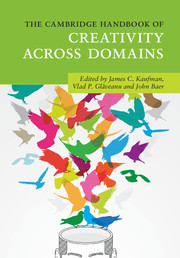Book contents
- The Cambridge Handbook of Creativity Across Domains
- The Cambridge Handbook of Creativity Across Domains
- Copyright page
- Dedication
- Contents
- Figures
- Tables
- Contributors
- Acknowledgments
- Part I Creativity and Domain
- Part II Creativity in the Traditional Arts
- 5 The Creativity of Literary Writing
- 6 Creativity in the Visual Arts
- 7 The Creation and Aesthetic Appreciation of Architecture
- 8 Photography and Creativity
- 9 The Constricted Muse
- 10 Musical Creativity
- 11 Dance
- Part III Creativity in the Sciences
- Part IV Creativity in Business
- Part V Newer Domains for Creativity Research
- Part VI Creativity in Everyday Life
- Part VII Conclusion
- Index
- References
11 - Dance
The Challenges of Measuring Embodied Creativity
from Part II - Creativity in the Traditional Arts
Published online by Cambridge University Press: 15 September 2017
- The Cambridge Handbook of Creativity Across Domains
- The Cambridge Handbook of Creativity Across Domains
- Copyright page
- Dedication
- Contents
- Figures
- Tables
- Contributors
- Acknowledgments
- Part I Creativity and Domain
- Part II Creativity in the Traditional Arts
- 5 The Creativity of Literary Writing
- 6 Creativity in the Visual Arts
- 7 The Creation and Aesthetic Appreciation of Architecture
- 8 Photography and Creativity
- 9 The Constricted Muse
- 10 Musical Creativity
- 11 Dance
- Part III Creativity in the Sciences
- Part IV Creativity in Business
- Part V Newer Domains for Creativity Research
- Part VI Creativity in Everyday Life
- Part VII Conclusion
- Index
- References
Summary
The human body and movement are the locus of dance and the intention is aesthetic appeal, whether it is expressions of exquisite beauty or ugliness. Creative research in dance includes the practical demands of a dance career and the imaginative potential embodied in the dancer. Dancers rely on their kinesthetic sense, also described as a somatic feeling, when they are creating. The creative experience is a merging of aesthetic awareness, imaginative engagement, and physical knowing. These are related to an affective experience that manifests in the dancers’ kinesthetic sensations and perceptions. Measuring creativity in dance necessitates an interdisciplinary approach, along with study designs that are qualitative and quantitative. Motor creativity encompasses neuroscience, physiology, and psychology; all offer insight into the complexity of non-verbal creative movement.
- Type
- Chapter
- Information
- The Cambridge Handbook of Creativity across Domains , pp. 181 - 196Publisher: Cambridge University PressPrint publication year: 2017



